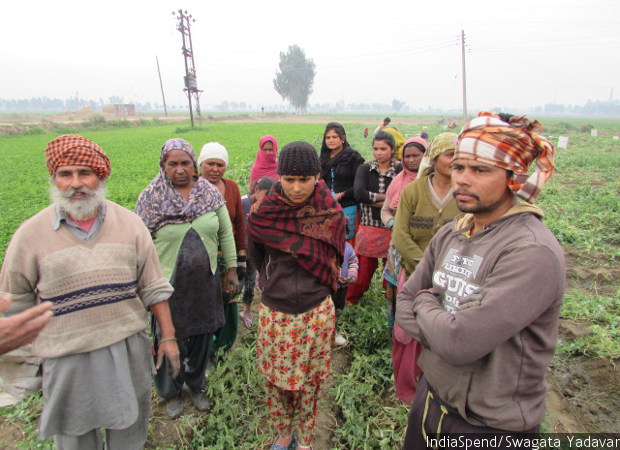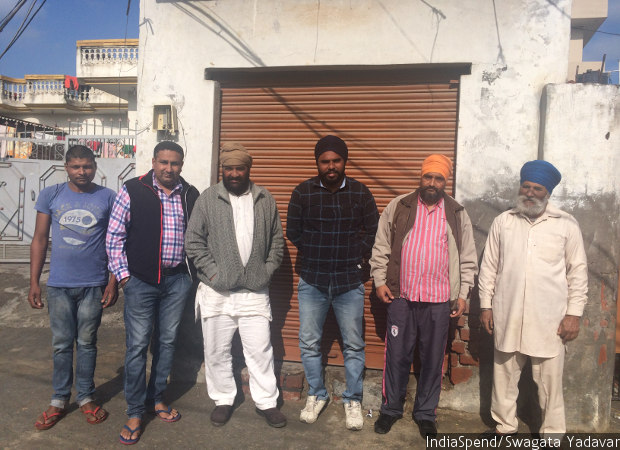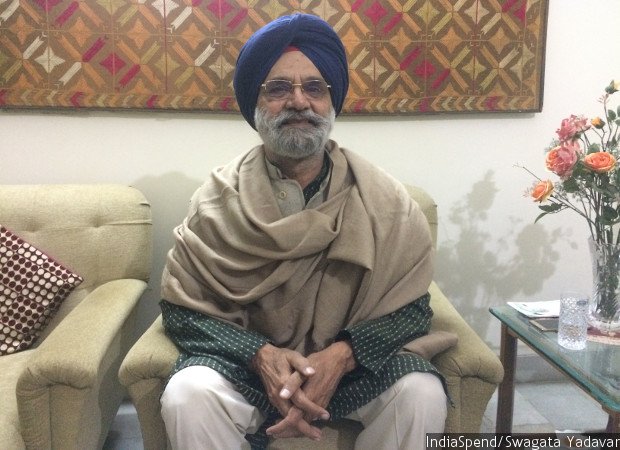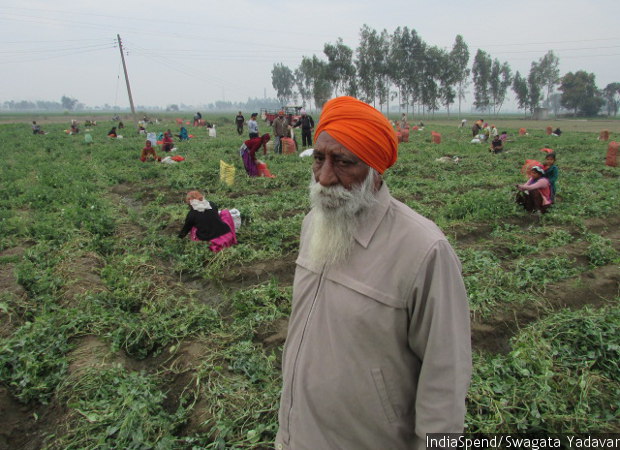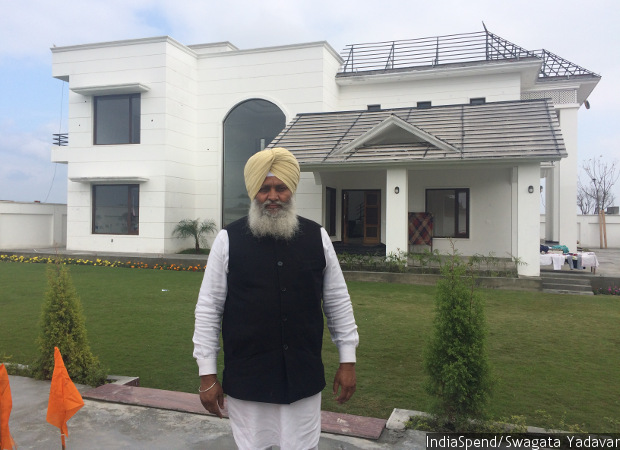Drugs, Despair And Decline Fuel Demand For Change In Punjab
Kashmir Singh (53, extreme left) and his son Daljeet (30, extreme right), a 10th-class pass, harvest peas in Pindiyan village, 40 km from the Pakistani border. In once-prosperous Punjab--proving ground of the green revolution--drugs, unemployment and a slowing economy have caused widespread anger and despair.
Kuch na honda Punjab da, zameen banjar, aulad kanjar.
(Nothing can come of Punjab--the lands are barren, the children are jobless.)
That extreme assessment of India’s 11th richest state was made by a drug kingpin in a dark, controversial film called Udta Punjab (Flying Punjab). The statistical reality, as IndiaSpend reported on January, 31, 2017, is that Punjab--ground zero of a green revolution that ended India’s image as a land beset by starvation--has failed to grow its economy or prepare its young people for the future. Employment and economic growth lag the national average.
The reality in Punjab--as IndiaSpend found after travelling through the districts of Amritsar, Tarn Taran, two rural and border districts and Ludhiana, an industrial centre--echoed the film and statistical assessment. The desire to leave their villages for better prospects elsewhere was common, and people expressed anger at the rise of drugs, the decline of jobs, and the failure of aspirations. The overriding demand: Change.
***
Amritsar, Tarn Taran, Ludhiana: It was cold and overcast at noon, when the clouds parted to allow in weak sunlight and much-needed warmth. We were in the village of Heir, 4 km south of Amritsar airport, where departures to Tashkent, Doha, Dubai and Singapore reflect the flight of the Punjabi from his native land. Along the broken road to the main village square, a group of men, young and middle-aged, sat around talking.
What, we asked, were the crucial issues for the assembly election of February 4, 2017? They answered in unison: Unemployment. “Look at us,” said Amrinder Singh, 34, science graduate, father of two. “It is the middle of the day, and all of us are sitting here whiling our time. There is nothing for us to do here.”
After his graduation, Amrinder--well built, smartly dressed in jeans and sneakers--did find a job at a private company. Dissatisfied with the Rs 15,000 salary, he resigned. Amrinder wanted, as many young Punjabis do, a government job. He applied, unsuccessfully, to be a physical-education teacher and police sub-inspector. “To get selected, one must pay bribe, sometimes upto Rs 20 lakh,” said Singh. “Even then, there is no guarantee that you will get the job.”
Amrinder Singh (34, centre in black shirt) wanted, as many young Punjabis do, a government job. He applied, unsuccessfully, to be a physical-education teacher and police sub-inspector. Singh has been unemployed for eight years, waiting for a government job.
Singh’s family does own farm land, but as families expand and farm sizes fall--from 3.9 hectares to 3.7 hectares over five years from 2005-06 to 2010-11, according to 2010-11 Agricultural Census data, the latest available--farming isn’t an option.
“Already, one brother is looking after the farm, what will I do?” asked Singh. Has he considered a business of his own? “Only those who have political backing can start a business,” Singh claimed.
The end result is that Singh has been unemployed for eight years, waiting for that government job.
“It’s not just me,” he argued. “Most of the young men in the village suffer the same fate. That’s why most of us are addicted to alcohol, tobacco or drugs. Three people from our village died of drug overdose in the last two-and-a-half months.”
Punjab’s drug problem is a political issue, with one part of the ruling Shiromani Akali Dal-BJP combine accusing Congress president Rahul Gandhi--who said one in 10 Punjabi youth were now addicts--of “defaming brave Punjabis”. In January 2017, Shiromani Akali Dal president Sukhbir Singh Badal was quoted as saying: “We are trying to save the youth of our country. The image of Punjab should not be tarnished... the Congress called us drug addicts and Rahul Gandhi tarnished the image of Punjabis by calling them so.”
Punjab’s deep and spiralling drug problem
There are nearly 230,000 opioid dependent and 860,000 opioid users in Punjab, according to the 2015 Punjab Opioid Dependence Survey, conducted by researchers from the All India Institute of Medical Sciences and Society of Promotion of Youth and Masses, a non-profit working towards prevention of drug abuse.
The survey of 3,620 drug-dependent individuals found that 99% of opioid dependents are male, 54% are married, and 55% are addicted to heroin, a synthetic opioid drug that causes feeling of euphoria and, at Rs 400 a gram, is one of the costliest drugs in the market. While 80% of addicts tried to quit, no more than 35% received professional help. Opioid dependents spent Rs 1,400 per day on drugs or an estimated Rs 7,575 crore statewide every year.
“Drug addiction is more a symptom than a disease,” said Ravinder Singh Sandhu, retired sociology professor from Guru Nanak Dev University, Amritsar. “Unfortunately, people still treat it as a personal and not a sociological problem.” Sandhu’s 2009 sociological study of 600 drug addicts from urban and rural Punjab found that 73.5% were aged between 16 and 35. Those who were illiterate (40.6%) and with education up to fifth grade (22.3%) were prone to drug addiction in rural areas, while those with a 10th-grade education (44.6%), or more, were susceptible to drugs in urban areas. One in four respondents was unemployed.
Ravinder Singh Sandhu, a retired sociology professor from Guru Nanak Dev University, Amritsar, said people still treat drug addiction as a personal and not a sociological problem. Sandhu's 2009 sociological study of 600 drug addicts from urban and rural Punjab found that 73.5% were aged between 16 and 35, and one in four respondents was unemployed.
“Drug addiction is directly linked with poverty and not with prosperity, as is the belief,” said Sandhu. He implicated the quality of education in Punjab as a reason for the dissonance between what young people aspire to be and what they become.
For instance, while literacy and the general education budget rose over a year to 2016-17, spending on primary education and incentives to retain students in school were cut, leading to a doubling in the primary school dropout rate in one year, we reported on January 31, 2017.
Thousands of semi-educated youth over the years were left unprepared for a job market that has jobs only for the best or, as Amrinder Singh in Heir village contended, for the well-connected. This failure of aspiration adds to the stress that fuels drug use, said Sandhu.
How a post-graduate in English, football player became drug addicts
Harinder (name changed) is 28, a post-graduate in English who could not find a job for four years. He and his friends first tried heroin, he said, because they were “bored”. He was hooked to the drug and soon found he needed a fix first thing in the morning and last thing at night.
Harinder’s family was well-off, and money was never a problem. He did think of quitting, but it did not work. “If you try to quit on your own, the whole system collapses, and the body aches,” he told IndiaSpend at the 250-bed Swami Vivekanand Government Drug Deaddiction and Rehabilitation Centre (one of five such centres in Punjab), where he had checked himself in.
For Kuljeet (name changed), 35--graduate, national-level football player and heroin addict--admitting himself was, as he put it, “the last chance to save my life”. He was once a security officer in Attari and started using opium largely out of curiosity. Kuljeet said he did not know of “side effects”, and when it became scarce, he switched to easily available heroin, which he dissolved in water and injected. He lost his job, and sold his wife’s jewellery. She filed for divorce and his six-year-old son is now in a boarding school.
It’s been five days for Kuljeet at the Centre, and he hoped he could get his life back--what’s left of it.
The role of personal morality and larger economic failures in the drug problem
A psychiatrist (requesting anonymity since the election code of conduct was in force and he isn’t authorised to speak to the media) treating drug addicts at the civil hospital of Tarn Taran, 25 km south of Amritsar city, said he saw up to eight new addicts and up to 30 follow-up cases every day: 80% of the addiction is related to heroin.
“When I started in 2008, most cases were of pharmaceutical drugs, such as morphine, lomotil, tramadol, but now heroin is more common,” he said, identifying the stigma involved as the greatest challenge in treatment. “Most people still see drug addiction as a moral failure,” he said. “In fact, it’s a chronic relapsing psychiatric illness with biological, social and psychological causes.”
There are larger economic failures that drive the drug problem in the border districts, which are especially vulnerable to drugs and report higher rates of addiction than inland areas.
“If the border districts were offered better health, education and employment facilities, they would not be tempted to smuggle drugs,” said J S Oberoi, a deputy inspector general with the Border Security Force, which guards the border with Pakistan. Many farmers with holdings between two and three acres, he said, work as drug-runners for as little as Rs 10,000 per run.
Caught between farms and city, dreams and reality, many Punjabis at a dead end
It is the pea-harvesting season and Kashmir Singh, 53, his family, and 30 other labourers are bending low to pick peas. We are in Amritsar’s Pindiyan village, 50 km from the industrial town of Jalandhar and 40 km from the Pakistani border.
“Usually, we have less than five months of work every year,” said Kashmir. During other months, he tries to get work as a casual worker in other villages or the nearby town. Since he earns less than Rs 60,000 a year and has no land, he is eligible for a government-issued “blue card”, the other requirement for which, in rural areas, is that you have less than 2.5 acres of land--it is also given to those with less than 100 sq. yards of land in urban areas.
But Kashmir hasn’t got his blue card, more than a year after applying.
Blue card holders also get atta or wheat at Rs 2 per kg and dal or pulses at Rs 30 per kg. He hasn’t heard of the 100 days of employment guaranteed by the 12-year-old Mahatma Gandhi National Rural Employment Guarantee (MGNREGA) Act. “We don’t have any such card,” he said.
Others around Kashmir knew of MGNREGA but alleged that most cards were held by village panchayat office workers, who siphoned off government payments, a common-enough problem with the world’s largest rural jobs programme, IndiaSpend reported in February 2016.
Kashmir’s son, Daljeet, 30, works alongside his wife and children. He is a 10th-class pass, and so is his wife. They would prefer working in a factory, but most factories around the area closed down some years ago. He has considered migrating to a city, but there isn’t land they can sell to buy a house and renting is expensive. So, they are stuck in Pindiyan, with no job opportunities and no way of realising their hopes of a better life for their children.
The owner of the land Kashmir and Daljeet work is as unhappy as they are. Harbhajan Singh owns the two acres that he farms for wheat and peas. Over the last two months, he has lost Rs 35,000, as the rural economy temporarily collapsed after notebandi, as the November 8, 2016, withdrawal of 86% of India’s currency, by value, is called (you can read our special section here).
“Peas are sold at less than Rs 10 per kg, which does not even cover the cost of fertilisers, seeds and labour,” said Harbhajan. It is a good thing we don’t depend only on farming, added Harbhajan, who was a soldier for 18 years and worked as a security guard at a bank for 24 years and earns pension from both. One son is in the army, and the other other looks after the farm.
Harbhajan Singh was a soldier for 18 years and worked as a security guard at a bank for 24 years. He owns the two acres that he farms for wheat and peas. Over the last two months, he has lost Rs 35,000, as the rural economy temporarily collapsed after demonetisation.
“We are tired of both the Congress and the (Shiromani) Akali Dal,” said Harbhajan. “We will give chance to a new party this time.” Around his house, we notice posters and the flag of the Aam Aadmi Party, which now rules Delhi and hopes to gain ground or come to power in Punjab.
Industries decline, young people leave and anger wells up against the Badals
By now, Ranjeet Singh’s story sounds familiar. At 37, he runs a shop in Tarn Taran’s Darda village, which he cannot leave because his mother has cancer. Others like him have left, said Ranjeet, to seek opportunities in other states.
More than half the village--without healthcare or a ground for children to play--is scheduled caste, so they do not own any land. “Since there are no factories and farm work, we are forced to migrate,” said Ranjeet Singh, a portly man dressed smartly in grey pants, vest, pink shirt and red turban.
He introduced us to his neighbour, Devinder Singh, 22, an arts graduate with a diploma in electrical, industrial work. He is the most educated person in his family, but he had not found a job in two years. He unsuccessfully applied for a linesman’s job, another with the railways. Devinder was just back from Gujarat, where he was a factory worker for a month. His father has cancer, and his sister, a 12-class pass, is also unemployed.
The unemployment rate among its youth is 16.6% while the Indian average is 10.2%, as IndiaSpend reported. Punjab’s rural youth joblessness rate in 2015-16 was 16.5%; more than 7 percentage points higher than rural India’s 9.2%.
Youth Unemployment Rate, 2015-16
Source: Labour Bureau; Unemployment rate for persons between 18-29 years in percentage.
Punjab’s industries, services and overall economy grew 5.9% in 2015-16, but that lagged the national average of 7.6%. In 2016-17, with India’s growth is likely to fall below 7%, according to the latest government estimate, released on January 31, 2017, Punjab’s growth will recede further.
This slowdown was revealed at an industrial estate close to Darda, where we saw more than 15 shuttered factories, some overgrown with vegetation. Some villagers said these factories began to shut seven years ago for reasons they did not know or remember.
As many as 18,770 factories closed between 2007 and 2014, when the Shiromani Akali Dal was in power, the Hindustan Times reported on February 3, 2014, quoting right-to-information data obtained by the Punjab Pradesh Congress Samiti (Punjab state congress committee): 8,053 factories closed in Amritsar, and no new industries were started in Tarn Taran, Moga, Rupar and Mansa districts, according to the data.
We found much anger directed at the Badals, the family that controls the ruling Akali Dal faction.
“The Badals own most businesses in the state, so either you give them profits or they will squeeze your business,” alleged our driver Gurpreet Kahlon. “They were too busy making money for themselves to think of people’s good.” Kahlon has no further hopes from Punjab. He has worked in Qatar for three years and now plans to migrate to Australia, where his brother is a driver.
The Shiromani Akali Dal, as this Scroll investigation revealed on March 25, 2016, appears to have links to a diverse set of industries, from stone-crushing, sand mining, cable distribution, liquor distribution and bus transport. Two years ago, the Tribune also reported how the Badals had majority stakes in transport business, hospitality and media businesses.
In Heir village, ruling party claims--and the road--fall apart
Back in Heir, we met former sarpanch Balwinder Singh in front of his sprawling bungalow. Of the village’s 2,500 adults, 350 have government-issued blue cards--meaning, as we said, they have incomes less than Rs 60,000 per year and less than 2.5 acres of land--and 300 earn government pensions.
“We have made all roads pucca, except one whose work is pending because of the election,” said Balwinder. When we reached the main road of the village, his claims disintegrated, much like the road.
Balwinder Singh, a former sarpanch of Heir village, near Amritsar, in front of his sprawling bungalow. We asked him about the drug problem in the state, and he said: “When the parents can’t control their own children, how can they expect the government to?”
“This road has not been made in 20 years,” said Baljeet Kaur, whose husband worked 40 years in Dubai and son, despite being a graduate, works at menial jobs in an army canteen. “There are no street lights, and we don’t venture out at night because drug addicts hang out here.”
We asked Balwinder Singh about the drug problem, and he said: “When the parents can’t control their own children, how can they expect the government to?”
A few blocks ahead, we met tea-stall owner Narinder Singh, 36, a blue card holder who gets wheat and never pulses as he is supposed to.
“Every blue-card holder gets rations on time,” said Balwinder.
Narinder said he tried applying for funds to build a house under a government-subsidised housing programme, the Indira Awaas Yojana, but he didn’t get any money.
In Heir’s scheduled-caste block, Lakwinder Singh, 36, showed us the garbage-dumping yard and the sewage line that floods when it rains. He and his family are tired of the stink, but they don’t know where to complain.
“We have applied for money to build a toilet, but we didn’t get it yet so we have to defecate outside,” said Singh. “We do not believe any political party will fulfil its promise or make a difference in our lives.”
We storified our tweets from our travels in Punjab. You can read them all here.
(Yadavar is principal correspondent with IndiaSpend.)
We welcome feedback. Please write to respond@indiaspend.org. We reserve the right to edit responses for language and grammar.
__________________________________________________________________
“Liked this story? Indiaspend.org is a non-profit, and we depend on readers like you to drive our public-interest journalism efforts. Donate Rs 500; Rs 1,000, Rs 2,000.”


